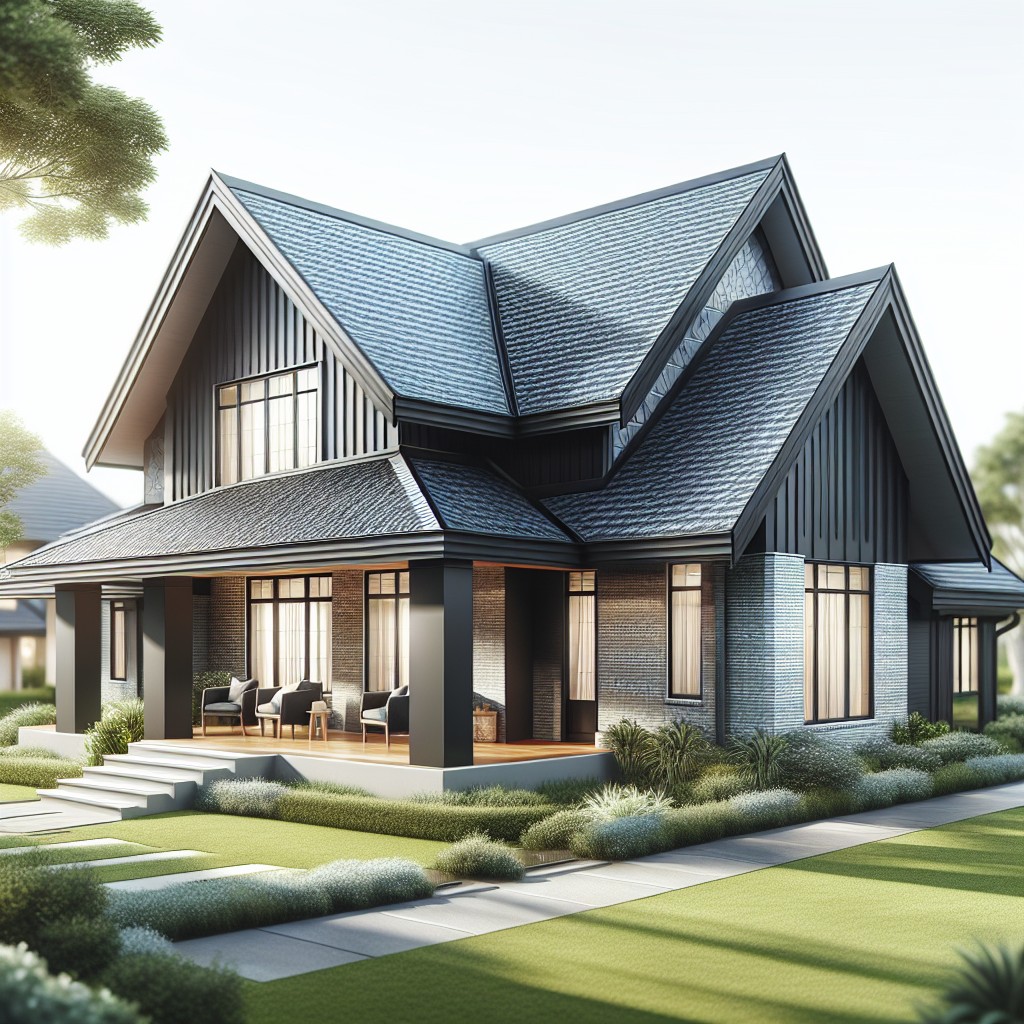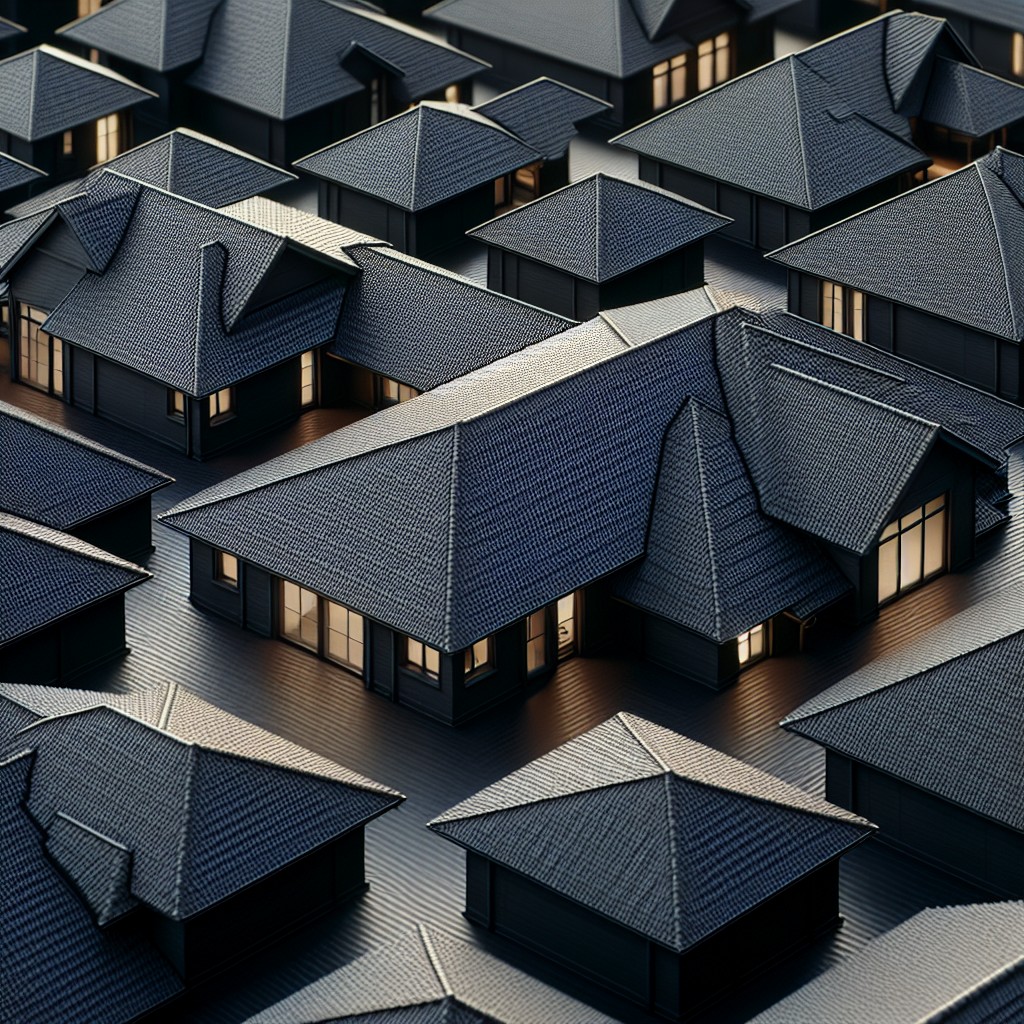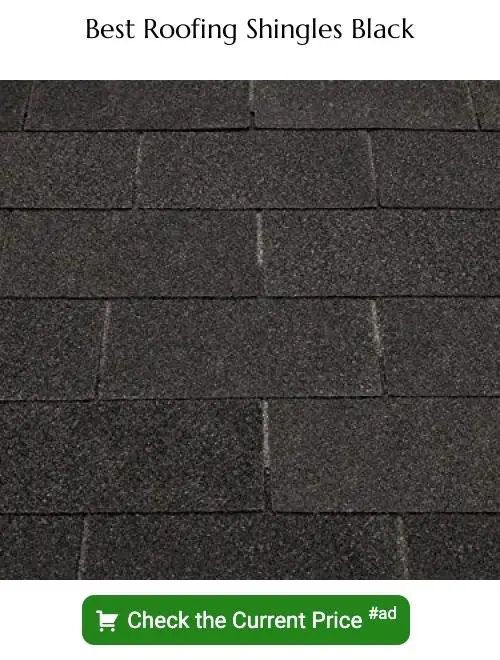Last updated on
Consider black roof shingles for your home because their unparalleled style, durability, and energy efficiency are revolutionizing modern roofing.
Key takeaways:
- Black roof shingles offer timeless style and increased curb appeal.
- Black shingles can help lower heating costs in colder climates.
- Advancements in black shingle technology improve energy efficiency.
- Regular maintenance is key to maximizing the lifespan of black shingles.
- Black roofs can absorb more heat and require more frequent cleaning.
Pros Of Black Roofs

Black roof shingles offer a timeless aesthetic, adapting effortlessly to various architectural styles from modern to traditional. Their dark hue provides a stark, attractive contrast against lighter-colored siding or brick, accentuating the home’s visual appeal and potentially increasing its curb appeal and value.
In colder climates, these shingles can help lower heating costs. The dark color naturally absorbs more sunlight, which can help to melt snow and ice on the roof more quickly and reduce the need for additional heating. Additionally, UV stability is often enhanced in black shingles, as the color effectively shields against the sun’s potentially damaging rays, potentially extending the roof’s longevity.
Finally, advancements in roofing technology have led to black shingles with reflective granules that combat the traditional heat absorption problem, offering a compromise that merges the beauty of black shingles with improved energy efficiency.
Design Flexibility

Black shingles offer a timeless look that complements a wide variety of exterior colors and styles. Whether you own a colonial, modern, or craftsman-style home, these shingles create a striking contrast that can enhance curb appeal and potentially increase home value.
Additionally, for those seeking a sleek, minimalist aesthetic, black roofs provide a clean, unobtrusive silhouette against the sky. They’re also versatile when it comes to matching with gutters, trim, and shutters, offering homeowners a uniform color palette that’s both classic and contemporary.
Lower Energy Costs
While it might seem counterintuitive, certain conditions allow black shingles to potentially contribute to lower energy costs. In colder climates, the dark hue facilitates heat absorption from sunlight, which can help melt snow and ice on the roof’s surface more quickly, reducing the weight and strain on your home’s structure. This characteristic can minimize heating needs inside the home as the retained heat can provide a measure of natural insulation.
Additionally, modern black shingles can be designed with special reflective granules mixed into the asphalt, designed to reflect UV rays, despite their dark color. Opting for these energy-efficient shingles can aid in maintaining more stable temperatures within the attic and subsequently throughout the home, promoting reduced energy usage in heating and cooling systems. It’s important to consult with a roofing professional to ensure that the selected black shingles are indeed energy-efficient and suitable for the specific climate in which your home is located.
Life Expectancy
The longevity of black roof shingles is a paramount concern for homeowners investing in a new roof. Typically, these shingles last between 15 to 30 years, but several factors can influence their lifespan.
Quality of installation, climate conditions, and maintenance frequency play critical roles. High-quality, properly installed black shingles can withstand extreme weather and resist cracking or curling.
Regular inspections and debris removal are essential in mitigating wear and tear, thus extending the life of the roof. Ventilation also significantly affects durability; proper air flow prevents heat buildup, reducing the risk of damage.
By paying attention to these aspects, homeowners can maximize the service life of their black roof shingles.
Cons of Black Roofs
While black roof shingles boast a range of advantages, they also come with some drawbacks worth considering.
One notable downside is their tendency to absorb more heat compared to lighter-colored shingles. This trait can lead to increased indoor temperatures during the warmer months, potentially raising cooling costs and straining air conditioning systems.
Additionally, the dark hue means black shingles may reveal dust, debris, and even streaks of algae more prominently, necessitating more frequent cleaning to maintain their aesthetic appeal.
Lastly, the higher heat absorption can sometimes result in accelerated aging of roofing materials. This effect might reduce the lifespan of your roof, leading to earlier-than-expected repair or replacement costs. By acknowledging these considerations, homeowners can make informed decisions about their roofing options.
Heat Absorption
Black roof shingles absorb more heat from the sun compared to lighter-colored shingles due to their dark hue, which increases thermal energy absorption. This can result in higher attic temperatures, potentially affecting your home’s indoor climate and increasing cooling costs, especially in warmer regions.
Here are key points to consider:
- Solar Radiation: Dark colors retain more solar radiation, causing black shingles to heat up more than lighter ones.
- Insulation Impact: Adequate attic insulation can mitigate the heat transfer from black shingles to your living spaces, maintaining a comfortable indoor temperature.
- Thermal Mass: Black shingles may contribute to the ‘heat island’ effect in urban areas, where increased demand for cooling can lead to higher energy consumption.
- Ventilation: Proper roof ventilation allows heat to escape, reducing the impact of the absorbed heat on your home’s interior.
Cleaning Requirements
Regular maintenance keeps black shingles pristine, enhancing your home’s curb appeal. Dust, debris, and algae are more visible against the dark backdrop. To avoid aesthetic decline and structural damage, adopt a proactive cleaning regimen.
Utilize a gentle wash solution to prevent discoloration — harsh chemicals can strip granules from the shingle surfaces, compromising their integrity. Also, avoid high-pressure washing techniques that can damage shingles.
Consider a professional cleaning service experienced with black shingle roofs. They can apply appropriate treatments to inhibit the growth of algae and moss, which thrive on moisture and are prevalent in humid climates.
Prune overhanging tree limbs to reduce debris accumulation and limit shade, as sunlight helps keep the growth of moss and algae in check. Furthermore, ensure your gutters are clear to prevent water buildup, as standing water can lead to mold and mildew, which are especially problematic for black roofs.
Premature Deterioration
While black shingles add a sleek look to your home, they can be prone to premature deterioration in certain climates due to their heat retention properties. Prolonged exposure to direct sunlight can lead to the breakdown of the asphalt in the shingles, making them less effective at repelling water and more likely to crack or warp.
To mitigate these effects:
- Choose high-quality, UV-resistant shingles designed to withstand intense sunlight.
- Ensure proper attic ventilation to reduce heat buildup that can accelerate deterioration.
- Regularly inspect shingles for signs of wear and address repairs promptly to extend their lifespan.
- Consider reflective or “cool roof” shingles that can absorb less heat while maintaining the desired aesthetic.
It’s important to weigh these maintenance considerations against the benefits of black roofing to determine if they’re the right choice for your home’s environment.
What Roofing Materials Are Available in Black?
Several materials for roofing shingles come in black, providing a range of options to suit different preferences and budgets.
Asphalt shingles are widely popular for their affordability and versatility. They often come in a black hue, which can provide a sleek, traditional appearance.
For a more durable option, metal roofing can also be found in black; it’s known for its longevity and energy efficiency.
Composite shingles are a newer option, designed to mimic the look of natural slate or wood shakes, and they too are available in black shades.
Architectural or dimensional shingles offer a textured appearance and are yet another choice that can be found in black, adding depth and character to the roof.
Lastly, rubber roofing, particularly favored for flat roofs, is available in black and is praised for its resistance to extreme weather conditions.
Each material offers distinct advantages, and the choice will depend on the specific needs and climate of the building.
Maintaining Your New Roof
Regular inspections play a crucial role in maintaining the integrity of black roof shingles. It’s recommended to conduct these checks biannually, typically in spring and fall, to identify and address potential issues promptly.
Cleaning gutters and downspouts ensures proper water flow and prevents water damage, which is particularly important for black shingles that may show less visible dirt accumulation.
Trimming overhanging branches minimizes debris accumulation on the roof, reducing the risk of scratches or punctures to the shingles.
Removing moss, algae, or lichen is essential, as these organisms can compromise shingle integrity. Utilize a dedicated cleaner and a soft brush or low-pressure wash to avoid shingle damage.
Prevent ice dams in colder climates by improving attic insulation and ventilation, which maintains a more consistent roof temperature and reduces the chances of ice dam formation that can lift or compromise shingles.
Finally, address minor repairs quickly, whether it’s replacing individual shingles or resealing flashings, to prevent small issues from evolving into major problems.
FAQ
Are black roof shingles good?
Black roof shingles are a popular choice due to their affordability, durability, aesthetic appeal, and energy saving benefits when installed properly with high-quality material.
What are the disadvantages of having a black roof?
Black roofs, on the downside, tend to absorb more heat, leading to increased indoor temperatures and potentially higher air conditioning expenses, particularly in warmer climates.
What is the blackest shingle you can get?
The blackest shingle available is the Charcoal Black color in the CertainTeed Landmark architectural shingle line.
How do black roof shingles affect your home’s energy efficiency?
Black roof shingles can lower energy efficiency as they absorb more heat from the sun, which then transfers to the interior of the home, leading to increased cooling costs.
Are there specific climates or environments where black roofing shingles perform best?
Black roofing shingles perform best in colder climates as they absorb heat and help in melting snow and ice.
Can black roof shingles impact the resale value of your home?
Black roof shingles can impact the resale value of your home, often positively, because of their aesthetic appeal and their ability to hide dirt and stains.





